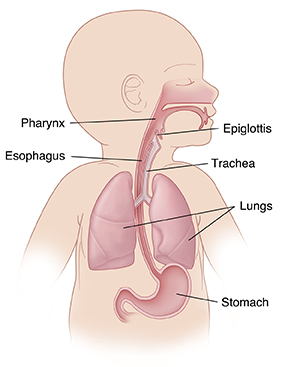Understanding Aspiration (Child)
Aspiration is when something enters the airway or lungs by accident. It may be food, liquid, or some other material. This can cause serious health problems, such as pneumonia. Aspiration can happen with these 2 conditions:
What happens when your child swallows
When your child swallows food, it passes from the mouth down into the throat. This is called the pharynx. From there, the food moves down through a long tube (esophagus) and into the stomach. This journey is made possible by a series of actions from the muscles in these areas. If your child has dysphagia, the muscles don’t work normally. They cause problems with swallowing.
The pharynx is also part of the system that brings air into the lungs. When a person breathes, air enters the mouth and moves into the pharynx. The air then goes down into the main airway (trachea) and into the lungs. A flap of tissue called the epiglottis sits over the top of the trachea. This flap blocks food and drink from going down into the trachea when your child swallows. But in some cases, food or drink can enter the trachea. It may go down as your child swallows. Or it may come back up from the stomach. A child with dysphagia is much more likely to aspirate. A child with a developmental or health problem is more likely to have dysphagia.

What causes aspiration
Some conditions can increase a child’s risk for aspiration, such as:
-
Stomach contents coming back up into the throat (GERD).
-
Abnormal anatomy, such as a cleft palate or a problem in the esophagus.
-
Delayed growth, from premature birth or a condition, such as Down syndrome.
-
Brain damage or other problems, such as from cerebral palsy or infection.
-
Problems with the cranial nerves that control the muscles of swallowing.
-
Neuromuscular disease, such as spinal muscular atrophy.
-
Medical procedures, such as a nasogastric tube or a tracheostomy.
Symptoms of aspiration
Aspiration can cause signs in a baby, such as:
-
Weak sucking.
-
Choking or coughing while feeding.
-
Other signs of feeding trouble, such as a red face, watery eyes, or facial grimaces.
-
Stopping breathing while feeding.
-
Faster breathing while feeding.
-
Voice or breathing that sounds wet after feeding.
-
Slight fever after feedings.
-
Wheezing and other breathing problems.
-
Repeated lung or airway infections.
Aspiration can cause symptoms in an older child, such as:
-
Choking or coughing while eating.
-
Voice that sounds wet after eating.
-
Slight fever after meals.
-
Complaints of food feeling stuck or coming back up.
-
Wheezing and other breathing problems.
-
Repeated lung or airway infections.
Symptoms can happen right after eating. Or they may happen over time. Your child may not have all of these symptoms. The symptoms may depend on the age of your child, and how often and how much your child aspirates.
Some children who aspirate don't have any signs or symptoms. This is called silent aspiration.
Diagnosing aspiration
Your child will need to be checked for aspiration if they have:
The doctor will ask about your child’s health history and symptoms. This may be done by a speech-language pathologist (SLP). The SLP may ask about what foods or drink cause problems, and when your child’s symptoms occur. They may want to watch your child during a feeding.
Your child may also need tests. These can check for problems. They can also show if food and fluid is going into your child’s lungs. The tests may include: